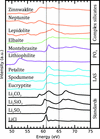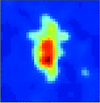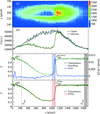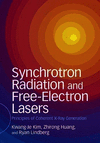issue contents
March 2018 issue

Cover illustration: Volume rendering representation of a free propagation phase contrast local area scan of an in situ mouse lung acquired in 10 s with less than 70 mGy and a pixel size of 25 µm using the MÖNCH detector (SYRMEP beamline Elettra) (see Dullin, Albers, Tromba, Andrä, Ramilli and Bergamaschi, pages 565-569). A detailed visualization of airways and blood vessel was achieved. The high frame rate and dose efficacy of MÖNCH might aid to a future in vivo application.
facility information
obituaries
Free 

research papers
The analysis of time-resolved X-ray scattering patterns collected at an XFEL upon photoexcitation of a di-platinum complex in solution is described. The analysis quantitatively considers the anisotropy of the signal.
The role of the axial-guide magnetic field on plasma-whistler-pumped free-electron laser operation is studied.
Sample delivery instruments and an experimental chamber (MICOSS system) have been developed and established to successfully conduct serial femtosecond crystallography at the Nano Crystallography and Coherent Imaging experimental station of the Pohang Accelerator Laboratory X-ray Free-Electron Laser facility.
Open  access
access
 access
accessA simple method to significantly enhance the coherence of X-ray free-electron laser (FEL) pulses by combining self-seeding and the harmonic generation mechanism is presented. This work is a fundamental step towards obtaining fully coherent FEL pulses, solving in this way a critical problem in the FEL field and its multidisciplinary scientific applications. In particular, the coherence improvement will be extremely beneficial for many photon science applications requiring a small bandwidth such as resonant inelastic X-ray scattering, therefore opening new areas of research and playing a crucial role in the future of all scientific users of the FEL facilities.
The application of a novel fast optical-imaging camera, TimepixCam, to molecular photoionization experiments using the velocity-map imaging technique at a free-electron laser is described. TimepixCam is a 256 × 256 pixel CMOS camera that is able to detect and time-stamp ion hits with 20 ns timing resolution, making it possible to record ion momentum images for all fragment ions simultaneously, thus avoiding the need to gate the detector on a single fragment.
PHYSICS | FELS
Open  access
access
 access
accessA new optical technique used to extract a specific harmonic of undulator radiation is proposed and the concept was experimentally confirmed using X-ray pulses from SACLA.
A comprehensive study of the performance of beryllium refractive lenses is presented. Combined results of the optical metrology and X-ray tests prove that Be lenses can be used in the X-ray free-electron laser oscillator cavity as an X-ray focusing element.
A novel in situ dynamic light scattering (DLS) module implemented at the PETRA III EMBL beamline P12 is capable of performing real-time sample solution scoring in parallel with BioSAXS experiments, including a multi-channel DLS detection principle.
Open  access
access
 access
accessA novel diced spherical quartz analyzer for use in resonant inelastic X-ray scattering is introduced, achieving an unprecedented energy resolution of 10.53 meV at the Ir  absorption edge.
absorption edge.
Open  access
access
 access
accessPolarization calibration of the photon beam produced by an APPLE-II undulator using a multilayer-based soft X-ray polarimeter is presented.
The general layout of the femtoslicing facility at SOLEIL is presented.
Standardized production of 40 µm-thick duo-lateral resistive electrode diamond position-sensitive detectors has been elaborated. This new X-ray beam position and intensity monitor has been characterized and a detailed position resolution analysis has been carried out.
A transmissive X-ray detector based on ultrahigh-purity single-crystal diamond is fully characterized regarding responsivity, including linearity and homogeneity, transmittance and X-ray scattering. A refined value for the mean electron–hole pair creation energy of diamond is obtained.
The performance of a new hybrid pixel detector is assessed with the aim of providing a single-photon-counting imager for time-resolved experiments presently under preparation at Synchrotron SOLEIL.
A graphene absorber, which consists of a graphene square array on top of a dielectric square array backed by a two-dimensional multilayer grating, is designed and investigated.
Results of computer simulations of the transmission of an X-ray beam through a two-dimensional photonic crystal as well as the propagation of an X-ray beam in free space behind the photonic crystal are reported.
Open  access
access
 access
accessThis paper reports the successful implementation of a method that enables the measurement of liquid–liquid and liquid–vapour X-ray reflectivity (XRR) curves using simply a fixed, horizontal source beam, a vertical translation stage and a two-dimensional detector. It will enable studies of liquid interfaces at sources lacking liquid diffractometers, especially ultra-fast XRR measurements via pump–probe techniques at X-ray free-electron lasers.
An automatic method for the extraction of Debye–Scherrer rings using a computer vision approach is presented. This technique not only introduces a new methodology to help calibrating automatically X-ray powder diffraction measurements but also provides an evaluation measure and two refinement strategies to improve the results.
The signal representing specific X-ray radiation-induced changes in crystals can be separated into distinct and statistically independent components by the independent component analysis method performed in real space. These components can be of native or difference electron density map types and can be interpreted in terms of physical processes and chemical and/or biological reactions.
Open  access
access
 access
accessA novel operando electrochemical cell with single-crystal sapphire X-ray windows has been designed for and successfully applied to the investigation of phase transformations and the valence states of the cations in high-power and high-voltage cathode materials for Li-ion batteries.
Open  access
access
 access
accessMössbauer reflectivity experiments performed using the Synchrotron Mössbauer Source at the ESRF demonstrate the high efficiency of such investigations for the analysis and understanding of multilayer structures and magnetization profiles.
An analytical model that accounts for the variation of dead-time with photon energy is proposed and tested experimentally. It allows accurate compensation for losses in spectra with more than half of the counts below 3 keV at a 56 kHz counting rate and compares favourably with the standard models in all experimental conditions.
The effects of bandwidth, spectral shape and high harmonics for undulator sources on SAXS measurements are evaluated quantitatively. Monodisperse and polydisperse systems are explored.
A new kind of unit impulse pulse-shaping method is proposed based on recursive calculation of a reset-type preamplifier and a C-R shaper. The unit impulse pulses generated in the detector are obtained in order to correct the counting loss in X-ray spectroscopy.
The binding mode and bonding nature between a uranyl cation and amidoxime ligand in aqueous solution were determined for the first time through experimental X-ray absorption spectroscopy and theoretical simulations.
Accounting for the finite core hole lifetime in X-ray absorption spectra calculation via adding an imaginary component to the energy and via convoluting the spectra on the real axis with a Lorentzian is equivalent only well above the Fermi energy.
Common solid P K-edge XANES energy calibration standards are reviewed and PPh4Br is proposed as a potential alternative.
Electronic structures of commonly used lithium-ion battery electrolyte solutions measured by non-resonant inelastic X-ray scattering method are presented.
The first experimental results at the Li K-edge of a variety of silicate and phosphate minerals are presented. The results are interpreted using information gained from simple Li-bearing salt compounds. The ionicity of the Li—O bond can be estimated using the presence of a weak edge feature as observed in Li metal.
A new two-dimensional velocity field extraction technique to overcome technological limitations is proposed.
Microbubbles containing gadolinium as contrast agents for both phase contrast imaging and magnetic resonance imaging are investigated.
short communications
Open  access
access
 access
accessThe high detective quantum efficiency of the novel charge-integrating hybrid detector MÖNCH enables in situ mouse lung imaging at a pixel size of 25 µm in 10 s with an entrance dose lower than 70 mGy, thereby enabling longitudinal in vivo synchrotron free-propagation phase-contrast computed tomography lung studies in mice.
beamlines
Open  access
access
 access
accessThe FemtoMAX beamline facilitates studies of the structural dynamics of materials on the femtosecond timescale. The first commissioning results are presented.
Open  access
access
 access
accessAn end-station for resonant inelastic X-ray scattering at beamline ID20 of ESRF – The European Synchrotron is described. The spectrometer is optimized for high-energy-resolution applications, including partial fluorescence yield or high-energy-resolution fluorescence detected X-ray absorption spectroscopy and the study of elementary electronic excitations in solids.
computer programs
A software package for data analysis of the arrival-timing monitor at SACLA is presented.
GAPD, a GPU-accelerated atom-based polychromatic diffraction parallel simulation code, is presented for direct, kinematics-based, simulations of X-ray/electron diffraction of large-scale atomic systems with mono-/polychromatic beams and arbitrary plane detector geometries.
Open  access
access
 access
accessThis paper describes benchmarking of the data analysis pipeline for X-ray diffraction computed tomography and CIF binary format byte-offset decompression on a GPU.
miXAFS is a program for analyzing X-ray absorption fine-structure (XAFS) data. It can analyze the XAFS functions simultaneously for all the obtained X-ray absorption edges and provide a surface plot of R-factor against two structural parameters.
book reviews
Free 

addenda and errata
Free 

Corrections to an equation and a figure in the paper by Paithankar et al. (2009). [J. Synchrotron Rad. 16, 152–162] are made.
current events
Free 



 journal menu
journal menu


































































